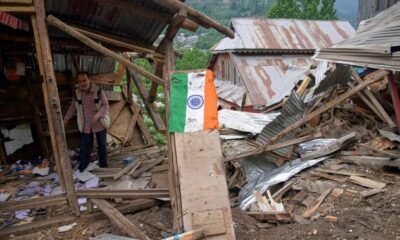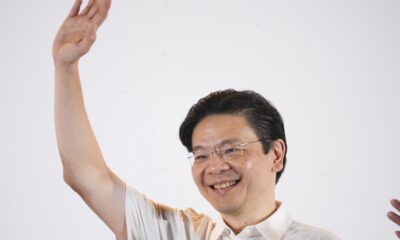Breaking News
Singapore has a housing model that works. Can Canada replicate it? – National

Urban planner Louisa-May Khoo says she got a sense of deja-vu when British Columbia Premier David Eby announced the BC Builds housing program earlier this year.
Khoo, a University of British Columbia public scholar, was a veteran of Singapore’s planning and development sector starting in 1996 before arriving in Vancouver in 2018.
When Eby unveiled BC Builds in February, Khoo said many Singaporean philosophies were instantly recognizable in the provincial program, right down to the exact percentage points in one instance.
“BC Builds has pegged their rental rates at 30 per cent of the household income, for instance, and that’s something the (Singapore Housing and Development Board) has always stuck by,” Khoo said.
“The StrongerBC economic plan is also pushing for things like a lot more upstream planning, which Singapore has always done for a long time,” she said. “Some of the regulations and proposals that I’ve seen in terms of the housing plan is very much inspired (by Singapore).”
Singapore’s housing model, where the government plays a dominating role in land ownership, property development, financing and other related aspects of society, has been held up numerous times by others such as Eby as a path to affordability here in Canada.
But the idea isn’t without its critics, especially when much of the policy may not be applicable in the Canadian social environment.
The BC Builds program aims to use “government, community and non-profit owned” land and $2 billion in low-cost financing to deliver middle-income homes.
Eby has said that more Singapore inspirations are coming for B.C.’s program.
“We’re starting with rental housing,” Eby said during a February announcement for BC Builds. “We’re going to move into housing for purchases as well. This is a model that has been used in Singapore, in Vienna … we know that it works, and we are taking that model and we’re expanding it dramatically.
“This is how we change the direction of housing.”
To make the change by adopting the full Singaporean model, however, will be difficult, said Sock Yong Phang, a Singapore Management University economics professor.
The Singapore-based researcher, who co-authored a 2016 Asian Development Bank Institute report on the country’s housing policies, said much of the country’s unique take on housing came out of necessity.
Full adaptation in a different environment, therefore, will prove challenging, she said.
Singapore faces an acute problem of land scarcity, Phang said. “(So) it is a holistic framework of land-use planning and allocation, housing supply delivery, housing finance and regulation of housing demand to ensure affordable home ownership.
“The framework in its entirety will be difficult to replicate in another setting.”
Singapore, often described as a city-state, houses most of its 5.9 million residents on one main island totalling 730 square kilometres. That area is smaller than every top-15 most-populated census metropolitan areas in Canada, with the closest being Oshawa, Ont., at 903 square kilometres.
Breaking news from Canada and around the world
sent to your email, as it happens.

Get breaking National news
For news impacting Canada and around the world, sign up for breaking news alerts delivered directly to you when they happen.
The lack of land was compounded by an equal lack in adequate housing when Singapore gained self-governance from Great Britain in 1959.
Phang wrote in the report that less than nine per cent of the population was living in public housing at the time “with the majority living in overcrowded prewar, rent-controlled apartments, lacking access to water and modern sanitation,” while “others faced housing conditions comparable to today’s slums.”
It led to the creation of the Housing and Development Board to build and sell public housing, as well as laws that gave government broad powers to acquire land for redistribution for “any public purpose.”
As a result, Phang said about 90 per cent of Singapore’s land is now state-owned, about 70 per cent of all housing units there are built by the government through the development board, and citizens are required to save money for retirement through a central fund that can be used to buy public housing.
The “tightly integrated land-housing supply and financing system” as described by Phang in the report resulted in Singapore having a 90-per-cent home-ownership rate since 1990.
“What we need to keep in mind when we think about Singapore is that it’s a city-state, so the entire population is clustered in one larger urban expanse,” said Kai Ostwald, director at the University of British Columbia’s Institute of Asian Research, who previously lived in Singapore.
“What that means in practice is that the kind of policies and the kind of interventions that a government in Singapore can make are next to impossible to replicate one-to-one in other contexts. So, at best, I think what’s possible is that some elements of the approach that Singapore has taken to public housing can be adapted to different contexts.”
For Khoo, one aspect of Singapore’s approach to housing that could be replicated in Canada is a more comprehensive approach to urban planning for decades ahead.
“Not only do we have the (long-range plan) to say, ‘OK, in 40 years, where do we see the country going?’ We actually then break that plan down in development phasing called the master plan, so for every site, or every neighbourhood, the planning then becomes a lot more specific,” Khoo said of Singapore’s model.
“It’s not just the housing, but it’s also the facilities that come with it,” she said. “So, the retail, the commercial … (the board) is actually responsible for the master planning of the town.”
Ostwald said the units in Singapore are also designed to create interaction between the residents.
“When you’re downstairs in the common areas, you’re also likely to encounter neighbours. That creates familiarity with the surroundings in a way that a lot of housing in Vancouver doesn’t allow for.”
He said he’s lived in different public housing units in Singapore in the last 25 years, “and in almost every case, within a couple of weeks, I knew my neighbours fairly well. And that has to do with the way that units are laid out.”
Singapore writer and activist Kirsten Han, who runs the We The Citizens newsletter analyzing the country’s human rights situation, said Singapore’s housing policy can be viewed as an extension of its broader vision for society, and planning extends into social engineering that may be hard for Canadians to accept.
For instance, Han said that besides eligibility rules limiting the purchase of public housing to citizens or permanent residents, the development board also has an ethnic integration policy and quotas that control the ethical mix in a community — down to the “block and neighbourhood levels.”
“The racial quota has been very widely praised abroad as, ‘Oh, this is how Singapore deals with racism and builds a multiracial society,’” Han said. “But if you talk to ethnic minorities in Singapore, they also talk about how it actually makes it harder for them to sell their flats.

“An Indian person can only sell to an Indian person if the quota is filled,” she said.
Han added that there is also the issue of the labour that’s needed to construct the housing projects, which in Singapore’s case often comes from foreign migrant workers.
Han said while Singapore is heavily reliant on these workers to provide labour, they are often housed in dormitories separated from other communities creating a significant social issue that is another part of the country’s housing model.
“Migrant workers are seen as just here to work and apart from that are dispensable and discardable,” she said. “So, it’s actually a very exploitative sort of relationship.”
But she said the treatment of the workers doesn’t seem to provoke enough outrage for the government to make changes.
The International Labour Organization in 2020 said Singapore had more than 1.4 million migrant workers that are crucial for construction as well as domestic work, and that number comprises 38 per cent of the country’s workforce.
Khoo said she has heard the criticism against Singapore’s housing model, but it does not take away from the fact that policy has largely achieved what it set out to do: Provide citizens with a pathway to affordable home ownership.

“I do believe that Singapore has done housing well,” she said. “It is certainly a beacon that holds hope for other
-

 Destination8 months ago
Destination8 months agoSingapore Airlines CEO set to join board of Air India, BA News, BA
-

 Breaking News10 months ago
Breaking News10 months agoCroatia to reintroduce compulsory military draft as regional tensions soar
-

 Gadgets3 months ago
Gadgets3 months agoSupernatural Season 16 Revival News, Cast, Plot and Release Date
-

 Tech News12 months ago
Tech News12 months agoBangladeshi police agents accused of selling citizens’ personal information on Telegram
-

 Productivity11 months ago
Productivity11 months agoHow Your Contact Center Can Become A Customer Engagement Center
-

 Gadgets3 weeks ago
Gadgets3 weeks agoFallout Season 2 Potential Release Date, Cast, Plot and News
-

 Breaking News10 months ago
Breaking News10 months agoBangladesh crisis: Refaat Ahmed sworn in as Bangladesh’s new chief justice
-

 Toys12 months ago
Toys12 months ago15 of the Best Trike & Tricycles Mums Recommend

























